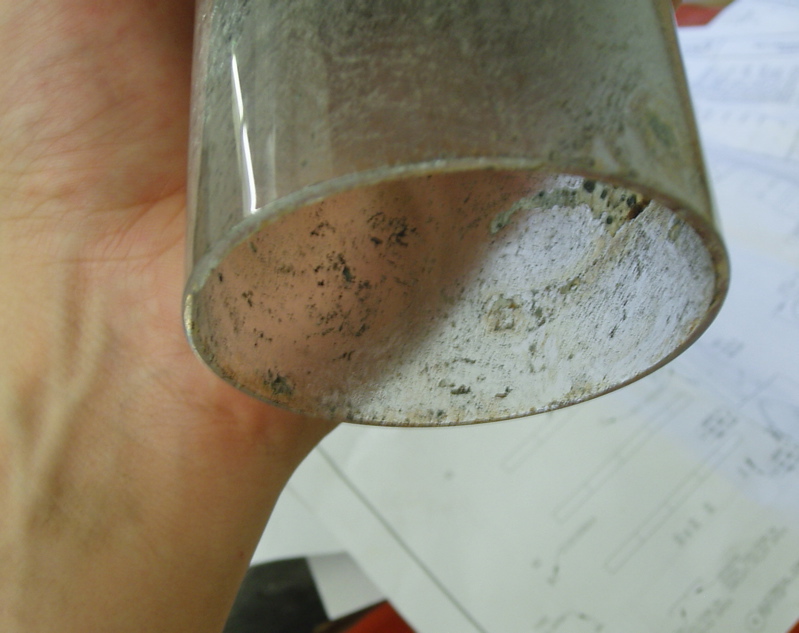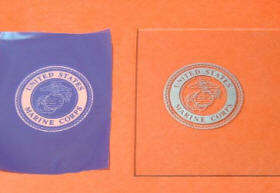ProfMadScientist
Harmless

Posts: 3
Registered: 8-7-2005
Location: S.E. USA
Member Is Offline
Mood: Optimistic
|
|
Etching Pyrex to "Frost" or Roughen Surface
I need to roughen up some inside surfaces on many complex pieces of Pyex glassware. Blasting with abraisive gives the "perfect finish, but will
not work for small inside surfaces.
Corning Glass gave some vague reccomendations, one glassblower suggested I try a dilute slurry of abrasive.
I have tried concentrated HF, NH4F2 solution, NaOH, and one mixture of Acetic, Nitric, and HF. I have ordered some KOH, but have not tried it yet.
Everything I tried so far with the exception of abrasive blasting produced a smooth finish. I need a rough finish! I even accidentally dissolved some
of my test Pyrex tubes.
REWARD OFFERED!
I am open to any suggestions and promise "tacky yet fun" rewards to anyone who helps!
Professional Mad Scientist
|
|
|
neutrino
International Hazard
    
Posts: 1583
Registered: 20-8-2004
Location: USA
Member Is Offline
Mood: oscillating
|
|
Have you tried sandpaper? This gives some sort of rough surface, although maybe not the kind you're looking for.
|
|
|
12AX7
Post Harlot
    
Posts: 4803
Registered: 8-3-2005
Location: oscillating
Member Is Offline
Mood: informative
|
|
Hmm, small inside surfaces. Maybe a pump plus abrasive slurry? Such is also used to smooth intake ports for engines, so I'm told.  Dunno where the hell you'd find a pump for that though, besides carbide
hardware...ouch... Dunno where the hell you'd find a pump for that though, besides carbide
hardware...ouch...
Tim
|
|
|
Tacho
National Hazard
   
Posts: 582
Registered: 5-12-2003
Member Is Offline
Mood: No Mood
|
|
Once I fixed my heating mantle with neutral sodium silicate as a glue. When I heated a flask in it, the dry sodium silicate swelled to a white foam,
and some of it got stuck to the glass flask. The "stain" was rough like sandpaper after I washed away the silicate.
My sugestion is: get a test tube and "paint" the inside of the tube with neutral sodium silicate solution (sirupy). Let it dry. Put the tube
in an oven and heat beyond the point where silicate swells. Maybe some fusion of the silicate is necessary. Wash away the silicate.
I'm not sure this works, but it's easy to try if you have silicate available. If you don't, tell me and I'll try for you. Not this
weekend though.
[Edited on 8-7-2005 by Tacho]
|
|
|
chromium
Hazard to Others
  
Posts: 284
Registered: 27-6-2005
Member Is Offline
Mood: reactive
|
|
I just read from old book that fumes of hydrofloric acid etch glass and make frosted surface in contrary to the aqueous solution. No more data
available though. :-(
|
|
|
uber luminal
Hazard to Others
  
Posts: 124
Registered: 25-8-2004
Member Is Offline
Mood: No Mood
|
|
glass and borosilicate are not the same.
49% HF will etch glass to frosty surfaces. Not so much for Pyrex. it will just disolve not-so-rough pits in the surface. (at room temp)
I assume that with pyrex, if it is heated to around the annealing temp, and coated with another material which cools faster than the pryex (and
shrinks), you may be able to rupture the surface without creating cracks in the whole piece. I have done something related with SiO2 with great
success. However the big difference is SiO2 is very resistant to thermal shock (when you apply the material... say in my case, liquid copper). But
there are a lot of other metal alloys that could be applied in liquid form (with lower MPs for the pyrex of course, so long as they shrink and cool
faster), cooled down slowly and then use something to dissolve the metal into solution. Then hopefully be left with a pseudo-spalled pyrex surface.
**edit. by SiO2 I mean quartz
[Edited on 8-7-2005 by uber luminal]
|
|
|
12AX7
Post Harlot
    
Posts: 4803
Registered: 8-3-2005
Location: oscillating
Member Is Offline
Mood: informative
|
|
Borax?
Maybe not strong enough... could toss in some SiO2 and PbO2 or other strong fluxes. Kinda odd to think of melting glass in glass, but you're the
one who wants to partially destroy it, so... 
At any rate, any glass containing lots of sodium and potassium will shrink nicely on cooling.
Only problem is removing it later, borax tends to be water soluble after fusing. Lead might give troubles but nitric acid could perhaps eat it yet.
But if that isn't strong enough, you'll have to use SiO2 additions, which will be eaten along with the pyrex if you HF it...
Tim
|
|
|
chemoleo
Biochemicus Energeticus
    
Posts: 3005
Registered: 23-7-2003
Location: England Germany
Member Is Offline
Mood: crystalline
|
|
I am VERY surprised HF doesn't do the job, considering this is used in industry. What was the concentration?
Also, melting NaOH/KOH may be a choice, they are known to attack glass when molten.
Edit: Sorry, I didnt realise you mentioned NaOH already. Very strange.
[Edited on 9-7-2005 by chemoleo]
Never Stop to Begin, and Never Begin to Stop...
Tolerance is good. But not with the intolerant! (Wilhelm Busch)
|
|
|
Tacho
National Hazard
   
Posts: 582
Registered: 5-12-2003
Member Is Offline
Mood: No Mood
|
|
In my experience, HF solution only dissolves the surface of glass leaving a smooth surface behind. HF solution FUMES make glass frosty.
|
|
|
S.C. Wack
bibliomaster
    
Posts: 2419
Registered: 7-5-2004
Location: Cornworld, Central USA
Member Is Offline
Mood: Enhanced
|
|
Well, I do know from experience that hot phosphoric acid + other stuff will do some frosting, but this was superficial and also not borosilicate
glass. I wonder if maybe this was due to HF from fluoride in the phosphate that I made the H3PO4 from, as this was from crap-grade phosphate IIRC.
Still, H3PO4 is mentioned in a few books as an etcher so I don't know. HF/H3PO4 has been recommended for etching but this is probably a bit
smooth.
A quick look at espacenet using
glass etching
or
glass etching composition
as search terms within patent titles showed a few patents.
But of course these won't refer to Pyrex much, if at all.
I was looking at a US gov't document today, "Techniques for ruling and etching precise scales in glass and their reproduction by
photoetching with a new light-sensitive resist" (C 13.4:565), which in passing mentioned the use of low-solubility fluorides as the preferred
method of making a rough etch, HF being smooth. I've always evaporated my NaF solutions in polypropylene, so I've no clue what soluble
fluorides do. This says nothing of borosilicate glass, though. A Googling of Armour glass etching cream says that it doesn't work on Pyrex. Hot
hydroxides + other stuff sure etches Pyrex, but this is smooth and transparent in my experience.
|
|
|
unionised
International Hazard
    
Posts: 5126
Registered: 1-11-2003
Location: UK
Member Is Offline
Mood: No Mood
|
|
The Merck index gives a material called "diamond ink" for etching glass. Based on HF and BaSO4 etc. Don't know if it works on pyrex.
|
|
|
chromium
Hazard to Others
  
Posts: 284
Registered: 27-6-2005
Member Is Offline
Mood: reactive
|
|
One more idea:
What if you spray some paint (that resists HF and can be dissolved with organic solvents) onto glass surface before etching your pyrex with HF.
Afterwards you have to clean glass surface with solvent and repeat this procedure again. This should give rough surface if repeated many times though
this may be too time conusming to be usefull.
|
|
|
neutrino
International Hazard
    
Posts: 1583
Registered: 20-8-2004
Location: USA
Member Is Offline
Mood: oscillating
|
|
Why would you have to repeat?
Wax would work for this as it isn't attacked by HF.
|
|
|
Mr. Wizard
International Hazard
    
Posts: 1042
Registered: 30-3-2003
Member Is Offline
Mood: No Mood
|
|
An easy method of etching glass, that can be used with a tape mask to get patterns is to shake lead buckshot mixed with a little carborundum or
silicon carbide abrasive , or any other abrasive for that matter. The abrasive becomes lodged in the softer lead and when shaken inside a box will
etch any glass it hits. Etching the inside of a vessel would be as easy as putting in the shot, adding a little abrasive, then shake rattle and roll
:-) A tumbler could even be used. I got this from an old "how to" book.
|
|
|
uber luminal
Hazard to Others
  
Posts: 124
Registered: 25-8-2004
Member Is Offline
Mood: No Mood
|
|
As I was mentioning above (about using cooling metal to spal the surface of the pyrex) here is an example photo of some that I roughed up yesterday.
note how normaly you would see right through crystal clear, but instead it fuzzy. the surface is rough and etched feeling. I spalled this surface with
Aluminum oxide.
the rest of the stuff in there could be dissolved out, leaving the rough surface behind.

|
|
|
Primathon
Harmless

Posts: 12
Registered: 21-7-2005
Member Is Offline
Mood: complacent
|
|
Research results
I finally got around to doing a bit of research on this, and I think I've found what you're looking for.
This place sells some pretty sweet glass etching materials. Namely, reusable high-detail stencils that you can print from an inkjet printer.
These look really badass. I want one :-)
For an overview of the process (along with pics), check out this link. Here's a teaser image:

I'm sure that if your goal is just to rough up the entire surface, you would just omit the stencil and be good to go. I'll let you take it
from here.
Oh, and you were offering a reward  ? ?
|
|
|
Texium
|
Thread Moved
19-11-2023 at 10:44 |